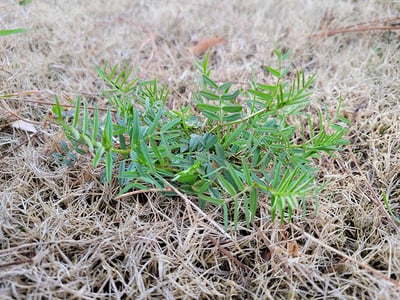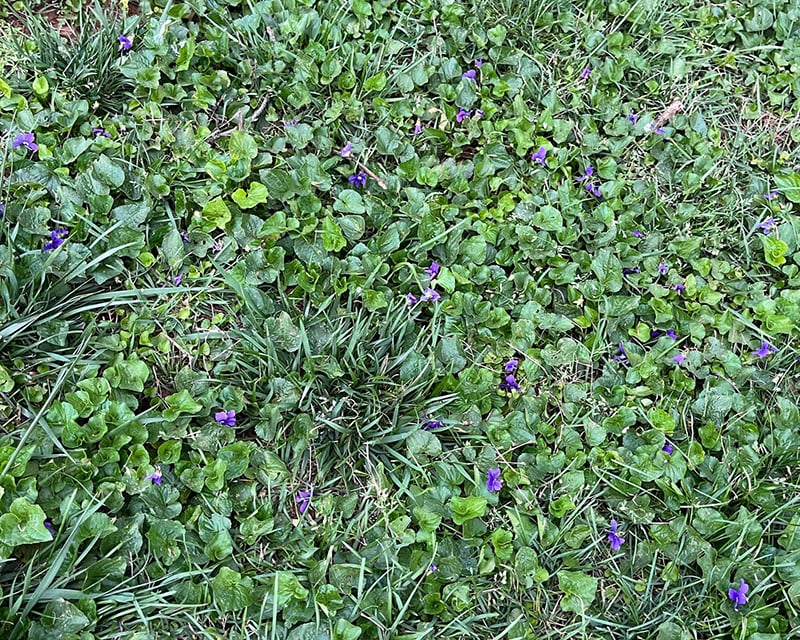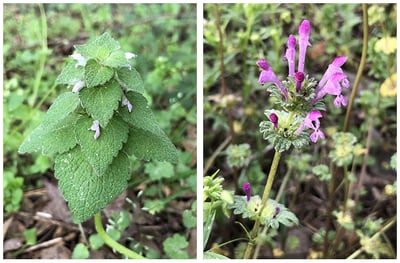

As I sit here in my office on a beautiful early April day in East Tennessee, I can smell the fresh cut grass from the yard across the street as the neighbor mows. The fescue is really thriving with the warming spring temperatures, but it is not the only plant. Viola sororia, the common blue violet, is also enjoying the beautiful weather. We'll cover how to identify and control it.
The common blue violet has some aliases as well. It is sometimes referred to as the meadow, purple, hooded, or the wood violet. The plant is herbaceous, meaning it is not woody.
Viewing Tip: Increase the volume and the playback speed according to your preferences. Volume control is the speaker icon on the lower left; playback speed is the gear button on the lower right.
General Violet ID Features:
To control violet weeds, we first need to learn how to identify it.
- Family: Violaceae
- Habit: Clumping
- Leaves: The leaves are heart shaped and glossy. On a mature plant they can be 3” long and equally wide.
- Roots: The leaves don’t come from a stem, rather they come from the rhizomes underground. This is part of what makes them hard to control.
- Flowers: Violets come in a wide variety of colors. They range from a deep violet with white throats to white with purple throats.
- Fruit/seed: A green capsule that blends in with the foliage.
Common violet taking over my tall fescue lawn.
The clumping or bunching habit of a single plant.
Flowers - notice the white throats that help identify it from other violets.
Heart-shaped leaves.
Eat it or Treat it - How to Control Violets
Although violets may be problematic in a lawn, many species of insects and wildlife rely on these early spring bloomers. Bees love to come and pollinate the flowers. Deer, rabbits, and birds also consume the vegetation.
Humans can consume this plant as well. While it doesn’t have much for a flavor profile, it is very high in vitamin A and C. The Cherokee Tribe used these plants to treat colds and headaches, and the flowers can be used to make jellies and candies. People tell me that the old-timers here in Tennessee make wine with these violets.
So, violets in the lawn aren’t welcome, but leaving them growing in mulch beds or more wild parts of your landscape can be a beautiful burst of color in early spring.
This perennial violet spreads by rhizomes and from the seeds produced by the flowers in early spring. If you don’t control these in a lawn, they can overtake areas very quickly.
Violet Weed Prevention:
- Pre-emergent herbicide: Common violet is a perennial that spreads via the roots and from seeds, so pre-emergent will only stop the spread of the plants by seeds. Keep that in mind when you spread pre-emergent and wonder why it's not working - it is working, but you will still need to address the existing population. Order pre-emergent directly from us in our herbicide store and spread it in February, April, and September.
- Mulch: If you don't want to let the violets grow in your flowers beds, mulch will help prevent them (and other weeds) from germinating there.
- Fix Bare Spots: If bald spots develop in your lawn, correct the underlying problem (such as compaction), get individual rolls of sod, and cover those bare spots before more weeds germinate there.
Manual Removal of Violets:
- Hand pull: You may need a trowel or small shovel to get up the big clumps, but otherwise it's not too hard to weed by hand - except that there are sometimes a lot of big clumps if it's gone unchecked.
- Mow: Mowing helps slow them down, but this perennial species will not be eradicated by mowing.
Chemical Control of Violets:
- Post-emergent herbicide: Super-Sod sells Three-D products that will help control them. It will take a few applications to gain full control in your yard so I recommend adding a surfactant to your mix. This will help the herbicide to stick to the glossy leaves. This can also be found at your local Super-Sod and in our online store.
Other Violets
The white and purple types are sometimes referred to as Confederate violets and classified as Viola sororia f. priceana. There is a plethora of different violets because they cross pollinate very easily. You can find many of these hybrids in your local garden store, just keep in mind if you plant them, they will spread.
You may find the light blue Confederate violet in your lawn too.
Johnny jump ups (Viola tricolor), the winter annual bedding plant, are closely related. Photo by Hillary Thompson.
The common blue violet is a native species that is found in Eastern North America from Mexico to Canada. Wisconsin (Go Badgers!), Illinois, Rhode Island, and New Jersey all recognize the common blue violet as their state flower. These plants enjoy cool moist soil, but can be found growing in full sun, like throughout my backyard.
Learn more about violets from these websites:
All photos by Paul Krueger, unless otherwise noted.
Questions? Leave a comment below.
Check back here for future weed profiles. Until then, happy weeding!




